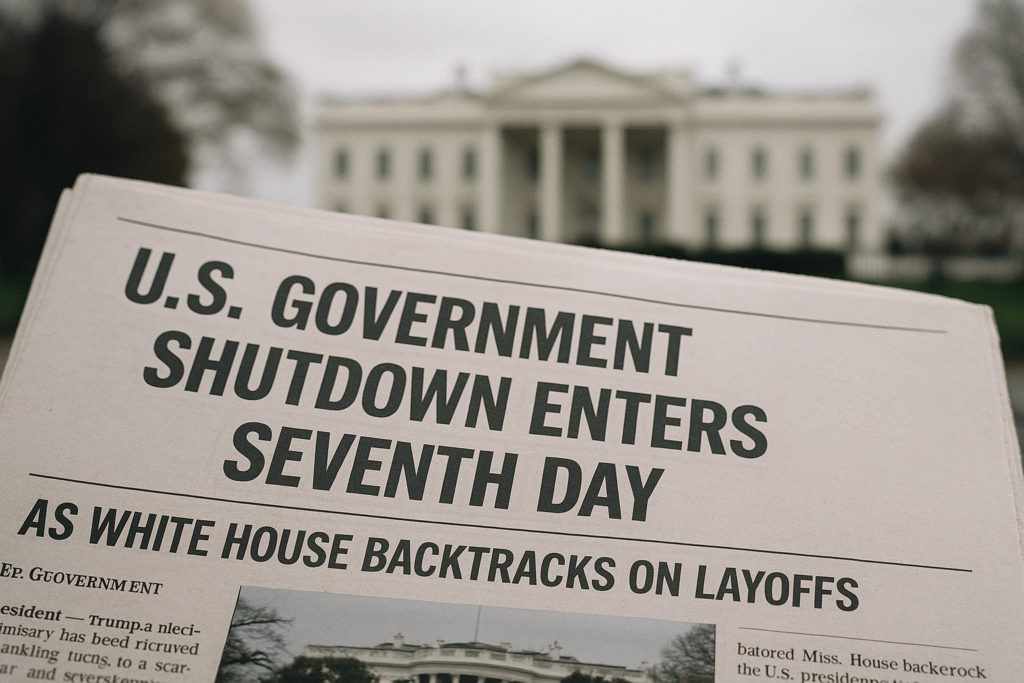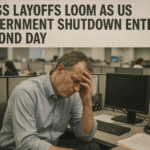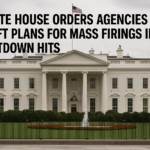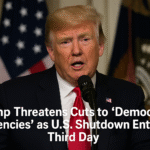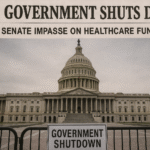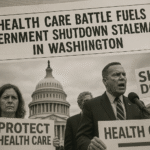By Harshit | October 7, 2025 | Washington, D.C. | 6:30 AM EDT
The standoff over federal funding shows no signs of resolution as the U.S. Government Shutdown 2025 enters its seventh day, with the White House clarifying earlier claims that mass layoffs of federal employees were already underway. President Donald Trump had suggested workers were being fired, but officials now say they were referring to furloughed employees since Congress allowed funding to expire on October 1.
Congressional Deadlock
The Republican-controlled Senate rejected dueling funding measures for the fifth time, blocking both a Republican plan to fund the government through November 21 and a Democratic proposal that also extends healthcare subsidies under the Affordable Care Act, which cover 24 million Americans.
Trump indicated openness to a deal on healthcare subsidies, which Democrats have demanded as the primary condition for approving any stopgap funding. Despite this, Senate Majority Leader Chuck Schumer denied that negotiations were occurring, while Trump insisted otherwise, highlighting the discord between the two sides.
The Republican-led House of Representatives remained out of session. Speaker Mike Johnson said he had no intention of reopening the chamber until a funding agreement was reached. “We’ve got probably 100 ideas for reforms on the table, but I can’t snap my fingers this afternoon and make that happen,” Johnson told a radio interview.
Backtracking on Layoffs
During the first week of the shutdown, the Trump administration threatened mass layoffs and cut off federal funding to Democratic-led cities and states. However, White House Press Secretary Karoline Leavitt clarified Monday that no active terminations have occurred, though agencies are preparing for the possibility if the standoff continues.
Labor unions representing federal employees have filed lawsuits arguing that potential layoffs would violate federal law, which carries criminal penalties. Meanwhile, at least $28 billion in infrastructure funds for states including New York, California, and Illinois have been frozen, drawing criticism from Democratic leaders. Some centrist Republicans also voiced concern that aggressive tactics could prolong the shutdown, intensifying pressure on both sides to reach a compromise.
Impact on Military, Transportation, and Public Services
The partial shutdown is poised to become the fourth-longest in U.S. history if it continues, surpassing the six-day closure in 1995 and trailing only the 35-day shutdown of 2018-2019.
The U.S. military faces immediate financial strain, with 1.3 million active-duty personnel and other federal workers expected to miss paychecks for the first time since the shutdown began. Air travel may also be affected, as more of the nation’s 13,000 air traffic controllers have called in sick. Transportation Secretary Sean Duffy warned that absenteeism could lead to delays, recalling disruptions experienced during the 2019 government closure.
Critical federal services, including national parks, regulatory agencies, and community health programs, have seen operations suspended. Citizens relying on Social Security, Medicare, and federal grants are feeling the ripple effects, raising concerns about both short-term disruptions and long-term economic impact.
Political Impasse
Republicans hold a 53-47 Senate majority but need at least eight Democratic votes to overcome the 60-vote threshold required for most legislation. So far, only two Democrats and one independent have crossed the aisle. Some Democrats have emphasized the need to resolve the healthcare subsidy issue before the ACA open enrollment period begins on November 1, adding urgency to the negotiations.
President Trump has emphasized the need for a “strong stance” in Congress, arguing that certain spending reforms are critical to long-term fiscal stability. Democrats counter that essential services and public welfare cannot be sacrificed for political maneuvering. With federal funds frozen, military paychecks pending, and critical government services disrupted, the American public remains caught in the crossfire of a high-stakes political standoff.
Public and Economic Pressure
Public opinion polls indicate frustration among Americans over the protracted shutdown. Economists warn that prolonged closures could slow economic growth, disrupt markets, and strain local governments reliant on federal funding. Business leaders are increasingly calling on Congress to find a compromise to avoid further disruptions to commerce and infrastructure projects.
As the shutdown stretches into its second week, all eyes remain on Capitol Hill. Whether a resolution emerges soon or the standoff continues, the effects of the U.S. Government Shutdown 2025 will likely reverberate through federal operations, the economy, and public confidence in government effectiveness.

